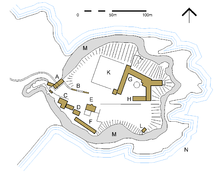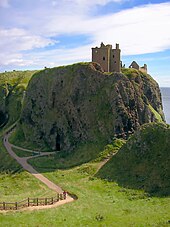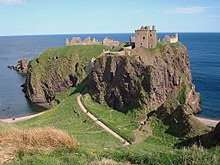Dunnottar Castle
| Dunnottar Castle | ||
|---|---|---|
|
Dunnottar Castle (2004) |
||
| Alternative name (s): | Dùn Fhoithear | |
| Creation time : | approx. 1200-1600 | |
| Castle type : | Rock castle | |
| Conservation status: | ruin | |
| Geographical location | 56 ° 56 '46 " N , 2 ° 11' 45.5" W | |
|
|
||
Dunnottar Castle ( Scottish Gaelic Dùn Fhoithear , "continue on the shelving slope") is a castle ruin in Aberdeenshire , Scotland . The ruin, located around 3 km south of the town of Stonehaven , stands on a rocky headland on the north-east coast of Scotland. The various buildings within the castle complex also include a residential tower from the 14th and a palace building from the 16th century.
Most of the buildings that can still be seen today date from the 15th and 16th centuries, although it is believed that a fortress-like structure stood on their site in the distant past. Due to its significant strategic location, Dunnottar Castle played an important role in Scottish history , particularly from the early Middle Ages to the Jacobite rebellion in the 18th century.
During the English Civil Wars, the Scottish Crown Jewels were hidden in Dunnottar Castle from Oliver Cromwell's troops invading Scotland , as he had already destroyed the older English Crown Jewels.
history
Early Middle Ages
The rock on which the castle stands was already inhabited in the Pictish times. It is said that St. Ninian founded a chapel here in the 5th century. Possibly the oldest evidence of early settlement can be found in the Annals of Ulster , in which two sieges of "Dún Foither" 681 and 694 are reported. The earlier event can be interpreted as an attack by Brude III, the Pict-King of Fortriu, who wanted to expand his power to the north-east coast of Scotland. In 900 King Donald II (officially the first King of Scotland) defended Dunnottar in vain against invading Vikings. He died and the Vikings destroyed the previous building of the castle. In 934 King Aethelstan of Wessex led his forces into Scotland and raided the areas around Dunnottar, according to a report by the historian Symeon of Durham . W. Douglas Simpson speculated that there was a moth under the current layer. However, this thesis could not be confirmed during excavations in 1980, as no conclusive evidence of early medieval fortifications could be found. Since the Fund Pictish stones at Dunnicaer, a nearby surf pillar is speculation about whether "Dun Foither" is actually km north 0.5.
Late Middle Ages
During the reign of William the Lion (1165-1214), Dunnottar was the center of local government in Kincardineshire . The first evidence of a castle on Dunnottar appeared in the early 13th century, and a chapel was added in 1276. The poet Blind Harry reports that William Wallace took Dunnottar back from the English in 1297. He is said to have locked around 4,000 defeated English soldiers in the castle church and burned them alive. In 1336 King Edward II of England ordered William Sinclair, the 8th Baron of Roslin, to send eight ships to the half-ruined Dunnottar to rebuild and fortify it as a base for his northern campaigns. Sinclair took 160 soldiers, horses, and detachments of stonemasons and carpenters with him to begin the work. The English efforts were thwarted, however, when the Scottish regent and military leader Andrew Murray marched his troops against Dunnottar and all defenses were again destroyed.
In 1382 Dunnottar Castle came into the possession of the Clan Keith , who rebuilt the castle once again. The tower block was completed a few years later by William Keith Marischal of Scotland , “ for the safe keeping of his people and his goods ”. William Keith's descendants, the Earls of Marischal, owned Dunnottar Castle until the 18th century.
Reconstruction in the 16th century
In the 16th century the Keiths redeveloped and expanded their two headquarters: Dunnottar Castle and Keith Marischal in East Lothian . In 1562 the Scottish Queen Mary Queen of Scots visited Dunnottar; In 1580 King James I stayed here for a while.
In the midst of the construction plans was Waterton's Lodging, a small house by the gatehouse. It was built around 1574, possibly for William Keith († 1580), the son of 3rd Earl Marischal . In 1581 George Keith became the 4th Earl Marischal and began a large-scale conversion of the medieval fortress into a homely and comfortable castle. In contrast to his predecessors, he valued Dunnottar for its picturesque location; Security aspects when converting to a castle complex were neglected. A “palace” with a series of buildings was built around a square inner courtyard on the north-eastern cliffs, creating luxurious quarters with a unique view of the North Sea. The chapel from the 13th century was rebuilt and integrated into the inner courtyard. In addition, an impressive stone gatehouse ( Benholm's Lodging ) was designed with numerous cannon hatches . However, these served here exclusively as decoration.
Civil war
Around 1639 King Charles I of England wanted to abolish the Presbyterian church constitution of Scotland and replace it with the Anglican Church . For this purpose the Scottish Episcopal Church was founded. It was not long before the Scottish people rose against England. The Covenanters , a Presbyterian movement, came together to openly oppose the Church of England. Eventually even William Keith, 6th Earl Marischal, switched sides and supported the Covenanters. Together with James Graham, 1st Marquess of Montrose , he marched against the Catholic Earl of Huntly and foiled the attempt of the royalists to conquer Stonehaven. But when Montrose moved to the Royalists, William Keith stayed in Dunnottar. Even when Parliament gave him command of the area and burned Montrose Stonehaven, he did not respond.
The Earl Marischal then joined the Engager faction and led a cavalry troop into the Battle of Preston in 1648 . After the execution of Charles I in 1649, the Engagers swore their loyalty to his son and successor, Charles II . He was then proclaimed King of Scotland. At that time he also visited Dunnottar Castle. Oliver Cromwell , the Lord Protector of the Commonwealth of England, could not and would not accept this coronation. So he sent soldiers to Scotland, who defeated the Scots in 1650 at the Battle of Dunbar . The final and decisive battle of the Civil War was the Battle of Worcester on September 3, 1651, in the course of which the MPs finally triumphed over the Scots.
The Scottish Crown Jewels
On January 1, 1651, Charles II was crowned king with the Scottish crown jewels (crown, sword and scepter) at Scone Palace . However, since Cromwell's troops were in Lothian, the Crown Jewels could not be returned to Edinburgh. The Earl Marischal, as the "Marischal of Scotland", was responsible for the insignia, and in June the Privy Council of Scotland decided to hide them in Dunnottar. Katherine Drummond took them to their destination, hidden in sacks of wool. Sir George Ogilvy of Barras was appointed lieutenant governor of the castle and was responsible for its defense.
In November 1651, Cromwell's troops asked him to surrender - he refused. During the subsequent blockade of the palace, Sir George Ogilvie's wife, Elizabeth Douglas, and Christian Fletcher planned to move the Crown Jewels. First, the royal documents were taken behind enemy lines by Anne Lindsay, a relative of Elizabeth Douglas; they were sewn into their clothes. There are two stories about the disappearance of the crown jewels. Mrs. Fletcher explained in 1664 that during three visits to the castle in February and March 1652, she hid the crown, scepter and sword between sacks of goods and carried them away. Another 18th century source reports that the crown jewels were lowered to the beach, where they were carried away by Fletcher's servants in a container of seaweed. After the Crown Jewels were removed from Dunnottar Castle, Mrs. Fletcher and her husband buried them under the floor of the old Kinneff Church.
Meanwhile, the siege commander, Colonel Thomas Morgan, had received siege guns capable of targeting Donnottar Castle and its defenders. As a result, Ogilvy surrendered on May 24 after a ten-day bombardment on the condition that the defending troops were granted freedom. After realizing that the Crown Jewels were gone, the English troops held Ogilviy and his wife on Dunnottar until the end of the year, when the false rumor slowly spread that the jewels had been taken abroad. The Earl Marischal was forced to sell much of the castle property and additional lands and possessions in order to pay the fines and reparations imposed by Cromwell.
After the reinstatement of Charles II in 1660, the crown jewels were brought from Kinneff Church and handed over to the king. Ogilvie soon quarreled with the mother of the Earl Marischal about his part in saving the jewels, although he was rewarded with the appointment of a baronet . Fletcher was awarded 2000 Merks by parliament , but the sum was never paid out.
Whigs' Vault
In 1685, during the rebellion of the Earl of Argyll, around 122 men and 45 women, so-called covenanters , were imprisoned in a cellar at Dunnottar Castle because they were Protestants and thus contradicted the royal sovereignty in all spiritual matters. This dungeon went down in history as the "Whigs' Vault". Most of them remained imprisoned for two months in a room measuring almost 50 m² and without sanitary facilities. 37 of them were released after revoking their convictions. 25 managed to escape, two of whom fell from the cliffs and 15 were recaptured. The rest died or were deported to New Jersey .
Jacobite era
During this time Dunnottar Castle was used by Jacobites and the House of Hanover . During the Scottish Uprising of 1689, 17 suspected Jacobites from Aberdeen were seized and held in the fortress for around three weeks. Among them was George Liddell, professor of mathematics at Marischal College. After the failed First Jacobite Uprising in 1715, all the possessions of George Keith, 9th Earl Marischal , an avowed supporter of Jacob II , were confiscated; he himself escaped the gallows only by fleeing to Prussia . Since the Jacobites removed all cannons from the fortress during the uprising, they weakened the castle so much that Dunnottar Castle had to be dissolved in 1718.
Later story
The Earl Marischal's confiscated lands were acquired by the York Buildings Company in 1720 for £ 41,172. In 1761 the Earl returned to Scotland and bought Dunnottar Castle back, only to sell it five years later. The new owner Alexander Keith, a lawyer from Edinburgh, held the rank of Knight Marischal and was after a short time also appointed baronet. In 1852 Sir Patrick Keith-Murray of Ochtertyre inherited the castle but sold it to Major Alexander Innes of Cowie and Raemoir in July 1873 for around £ 80,000. It was acquired by Weetman Pearson, the 1st Viscount Cowdray, in 1925. He and his family then started a project to stabilize and repair the existing building fabric and structure. The castle is still in the possession of the family who have given it up to visit. In 2009 alone around 52,500 tourists came to visit one of the most charming castles in Scotland. Charles Anthony Pearson, the younger son of the 3rd Viscount Cowdray, is the current owner of Dunnottar Castle, which is now part of the 210 km² Dunecht estate . The castle is best known today as the setting for the 1990 film adaptation of Hamlet with Mel Gibson .
For the animated film Merida - Legend of the Highlands , Dunnottar Castle served as a template for the castle in the film.
In 2013 the castle reached seventh place worldwide in a vote by Virtualtourist for the eighth wonder of the world. In a preliminary round carried out by Visit Scotland , Dunnottar prevailed against other Scottish sights such as Edinburgh Castle , Skara Brae or the Callanish complex .
Location and description

Legend: A gatehouse and Benholm's Lodging • B tunnel-like access • C Keep • D Old Forge • E Waterton's Lodging • F stables • G lock • H Chapel • I back entrance • J Whigs' Vault • K Bowling Green • L guardhouse • M cliffs • N North Sea
The main attraction of Dunnottar Castle lies in its picturesque location. The castle ruin lies on a rock made of red sandstone in the North Sea , which can only be reached by a narrow path from the mainland. This high plateau has an area of around four acres (approx. 16,000 m²) and is surrounded by steeply sloping cliffs (50 m high). This extremely strategic location allowed its owners not only to control the northern Scottish shipping routes, but also to control the coast and the endless hills.
building
Dunnottar Castle consists of eleven buildings erected between the 13th and 17th centuries. The gatehouse, the chapel, the "palace" from the 16th century, which also houses the "Whigs' Vault" prison, and other rooms and workshops can also be seen.
Tower House
The tallest building is the 14th century Tower House. This successful combination of residential tower and keep looks dominant from the mainland and almost seems to be an independent castle. The imposing building consists of a basement with stone vaults and three floors above. It houses a large hall, a kitchen and several bedrooms, an ornate chamber that was once set up especially for the lord of the castle, and there was even a fireplace and fireplace.
Tower house construction has a long tradition in Scotland; The aim is to achieve the best possible combination of comfortable living spaces and a fortified keep.
Gatehouse
The entrance to the castle leads through a very strongly fortified gatehouse, built in a crevice at the time. A second access to Dunnottar Castle is through a rock niche, which represents the opening of a cave created by the sea, on the north side of the cliffs. From here a steep path leads up to a well-paved rear entrance .
Palace
The palace, built by the 4th Earl Marischal between the end of the 16th and mid-17th centuries, consists of three wings and, together with the 13th century chapel, forms a square inner courtyard with an opening to the south. At the time, this was certainly an unusual design, as most of the buildings were rather tall. Here, however, a long and low structure was preferred.
The west wing had seven accommodations, all of which were open towards the inner courtyard, and there was even a gallery on the upper floor. From here a salon served as a connection to the north wing, to which a large dining room was connected. These included pantries, cellars and kitchens. Between the west and north wings, there is a passage to the north cliffs, called the Water Gate, on the ground floor. The east wing had a brewery, bakery and pantries, while the countess's private apartments were on the upper floor. A northeast wing comprised the Earl's rooms including the “King's Bedroom” as used by Charles II during his stay at Dunnottar Castle. Below is the famous Whigs' Vault and another dungeon with access through a trapdoor in the floor.
The north-west and south-east part of the castle was fortified with artillery positions that secured it inland, as well as north and south-east.
Individual evidence
- ^ Watson & Macleod (2010), p. 8
- ↑ Alcock & Alcock (1992), p. 269
- ↑ Anderson (1990), pp. 395-397
- ↑ Foot (2004)
- ↑ Alcock & Alcock (1992), pp. 281-282
- ↑ a b Entry on Dunnottar Castle in Canmore, the database of Historic Environment Scotland (English)
- ↑ a b c Geddes (2001), pp. 25-27
- ↑ a b c d Coventry (2006), pp. 278-279.
- ↑ Sumption (1991)
- ↑ Tabraham (1997), p. 92.
- ^ Howard (1995), p. 83
- ^ Howard (1995), p. 53
- ↑ Cruden (1981), pp. 223-224
- ↑ a b c d e Stevenson (2004)
- ↑ a b Groome (1885), pp. 442-443
- ↑ a b c d Baigent (2004)
- ↑ a b Henderson & Furgol (2004)
- ↑ Archive link ( Memento of the original from November 28, 2012 in the Internet Archive ) Info: The archive link was inserted automatically and not yet checked. Please check the original and archive link according to the instructions and then remove this notice. , Reference v. a. on historical sections.
- ↑ Handley (2004)
- ^ Betty Ponting: Mathematics at Aberdeen . In: The MacTutor History of Mathematics archive . St Andrews University. Retrieved November 6, 2012.
- ↑ Jervise (1875), p. 346
- ↑ Martinolli & Bereziat (2010), p. 35
- ↑ http://www.schottlandberater.de/artikel/weltwunder-nr8-dunnottar-castle.html
- ↑ http://www.scotsman.com/lifestyle/heritage/dunnottar-castle-the-8th-wonder-of-the-world-1-2949511
- ↑ http://www.exploring-castles.com/dunnottar_castle.html , v. a. Regarding building.
- ↑ a b c www.historicalwritings.wordpress.com ( Memento of the original dated February 21, 2014 in the Internet Archive ) Info: The archive link was inserted automatically and has not yet been checked. Please check the original and archive link according to the instructions and then remove this notice.
- ↑ a b c www.oocities.org
Web links
- http://www.dunnottarcastle.co.uk/ - Official website of Dunnottar Castle (English)
- http://www.albamusic.net/dunnottarcastle.html (English)
- http://www.undiscoveredscotland.co.uk/stonehaven/dunnottarcastle/ (English)
- http://www.weltbummeln.de/highlights/high_gros3.html









